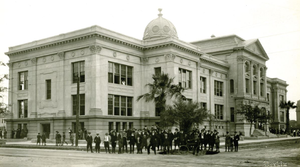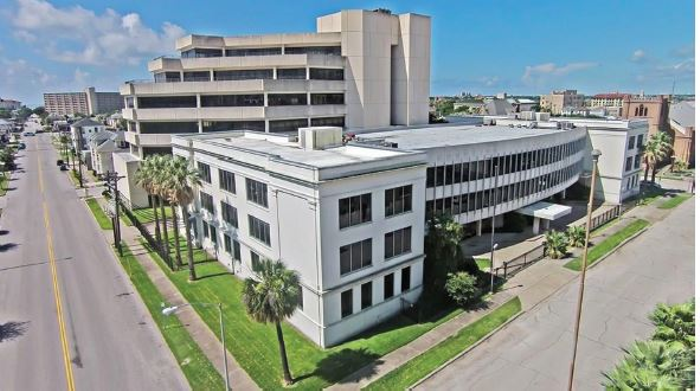The landscape of much of Galveston Island’s architecture is a testament to
the philanthropic actions of business leaders. Names like Moody, Sealy,
Hutchings, Mitchell, Rosenberg,
and Ball are revered on the island. The legacy of generosity has outlived the
donors, but it has helped shaped the island what it is today.
In 1845, John H. Hutchings formed a partnership with John Sealy and
George Ball, creating Ball, Hutchings, and Company. Hutchings negotiated the
bonds to construct the first bridge across the bay and was instrumental in
improving Galveston’s
harbor.
For his part, George Ball, a wealthy dry goods businessman, also
contributed large sums to asylums, hospitals, and public schools - always
without public fanfare - but his good works could not be contained. Too
many lives were changed for the better.
In 1883, Ball approached the Galveston
City Council with his desire to contribute $50,000 for a public
school to be built on land provided by the city.
He wrote: "If the authorities of this city will furnish appropriate
and sufficient grounds centrally located, I will contribute $50,000 for the
erection of a building to be permanently dedicated to the use of the public
free schools of the City of Galveston.
I will be pleased to carry (this proposal) into the earliest effect with the
hope that it may prove useful to the community with which I have been long
identified and whose future welfare I most earnestly desire."
That proposal was accepted. The school would be built at 21st and Winnie
streets. When it was complete, the building had 12 classrooms that served a total
of 200 students in grades 8-12, two offices, and an auditorium.
According to the Handbook of Texas, the cornerstone of what would become
Ball High
School - believed to be the oldest public school in Texas - was laid on Feb.
15,1884, at the southwest corner of the main portion of the building on Avenue
H at 21st Street.
The inscription on the cornerstone read: “George Ball to the Children of
Galveston.”
Beneath the cornerstone, city leaders buried a time capsule that
contained items related to the school’s incarnation: letters exchanged by Ball
and the city regarding the school, a photo of Bell, a copy of the school’s
floor plan, a copy of the Ten Commandments in Hebrew, and a collection of
coins, including several foreign coins collected by Ball.
It turned out to be the final act of a
generous soul: Ball died March 13, 1884, one month after the cornerstone
ceremony. The new public high
school opened its doors to 200 pupils later that year on October 1, 1884.
Six years later in 1890, his widow donated $47,000 to remodel, enlarge and beautify the
building, which included the addition of a rotunda and dome to the north front
of the building. It was a lovely building, and declared its pride with the
motto: "Best school south of St. Louis and
west of the Mississippi."
In 1900, a Category 4 hurricane devastated the island, and like many
structures, the school was heavily damaged. The hurricane, which killed an
estimated 6,000 to 8,000 people, remains the worst weather-related disaster in U.S. history in
terms of loss of life.
 By the start of the school year in 1901, the school was back in service,
thanks to its residents and philanthropic business leaders. Enrollment
continued to increase, and in 1915, two wings - which included six
classrooms - were added to accommodate the growing student population. By
1924, the student population necessitated additional space, and the wings were
expanded.
By the start of the school year in 1901, the school was back in service,
thanks to its residents and philanthropic business leaders. Enrollment
continued to increase, and in 1915, two wings - which included six
classrooms - were added to accommodate the growing student population. By
1924, the student population necessitated additional space, and the wings were
expanded.
For the next 30 years, the structure’s evolution stood still: No
additions were made to the existing structure. In 1952, the writing was on the
chalkboard: The school was simply too small, and construction began on a new
$3.2 million Ball
High School complex at 41st Street and
Avenue O. Two years later in 1954, the school moved to its new site, which
covered a four-block radius.
Soon after, the Galveston
Independent School
District sold the school’s original site to Texas
Prudential, which tore down much of the structure, including the dome - leaving
only the two wings that were added in 1915. The company also built a one-story
building connecting the wings and used the entire building for their offices.
Texas Prudential was sold to Western & Southern Life Insurance Company,
which remained in the building until American Indemnity purchased it in 1959.
 The link between the Hutchings, Moody, Sealy, and Ball families survived
and thrived - and all four families have a leaf on Ball High School’s
tree of life.
The link between the Hutchings, Moody, Sealy, and Ball families survived
and thrived - and all four families have a leaf on Ball High School’s
tree of life.
New Chapter
The Hutching and Sealy families, two wealthy Galveston families, founded American Indemnity,
a regional property and casualty insurance company. Sealy Hutchings, who had
been a member of the first graduating class of Ball High School
(class of 1887), served as president.
“Hutchings and Sealy hired my grandfather, Joseph F. Seinsheimer, who founded
and owned the Seinsheimer Insurance Agency, to serve as general manager,” says
Joseph F. Seinsheimer III, who is known as “Fellman,” and who served as
president and chief executive officer of the company until his retirement.
“Hutchings and Sealy had the capital. My grandfather had the insurance
knowledge. He incorporated the company in 1913, which makes it the first
stock-casualty company incorporated under Texas statutes. Hutchings and Sealy either
gave him shares, or he purchased shares, I’m not sure which. Sealy served as
president until 1931, when my grandfather was named president. Ultimately, our
family controlled the company, but they did not own the company.”
For more than 45 years, American Indemnity remained at the Hutchings-Sealy Building,
located at the corner of Strand and 24th
Street at 2326 Strand.
In 1959, it moved its operation to 21st and Winnie, the former site of the
original Ball High School from which its founder had
graduated. The company added a seven-story building and redesigned the entire
front portion of the property.
“At the time, The Strand was not a place where you’d want to be. It was
deteriorating, full of winos, and it wasn’t until sometime later that The
Strand began redevelopment. We were gone,” he says.
“In the late-1960s, we added two floors to the one story building that
faced Winnie Street,
sort of like a semi-circle shape. Those two floors that connect the three
stories on either end were the pieces left from the original Ball High School.”
A seven-story addition was erected behind the building in the
late-1970s, “which was where the original Ball High School, with the dome, once
stood. It faced Ball Street,”
he says.
In 1999, American Indemnity was sold to United Fire & Casualty
Company, which in turn sold the building to Amsalem & Segal Investments, a
private investor, who let the property languish for several years, until it
fell into foreclosure.
Enter the Cantor Group II, LLC, which has a new vision for the site. The
unique property consists of two office buildings linked together on one city
block, a total of more than 134,000 square feet of usable space that includes a
three-story main building, seven-story tower building - which affords
amazing island views, especially on the 6th and 7th floors, both of which have
large outdoor terraces. In addition, there are 155 parking spaces with one
separate parking lot at the corner of Sealy and 22nd streets, a hot commodity
in a tourist community.
What remains of the original Ball High is being leased to mixed-use
commercial businesses, and the seven-story tower behind the building will be
converted to condos or apartments, says Michael Kluchin, representative of
Cantor Group II.
“We came upon the property sometime in 2015, and took it over through foreclosure.
It just was a great property, and it had a lot of history and a lot of life to
it,” Kluchin says.
“It’s been vacant for many years, and it deserves to be revitalized. Our
vision for it is to take the Ball High portion of the building and use it as a
mixed-use commercial development, and then turn the seven-story addition into
residential units. Because it’s a historic building, we want to preserve that
history, so we’ve hired a well-known Galveston
architect, David Watson, to work on the project. We anticipate starting work on
the building sometime in June. It’s going to be a complete renovation.”
Kluchin says the first floor of property is already being marketed for
the mixed-use side - Eric Tucker, a Realtor with Joe Tramonte Realty Inc.,
is the listing agent - “and we’ve had a lot of interest. We’re considering our
options. We anticipate moving forward with the residential portion sometime
next year.”

Kluchin says he’s been to Galveston
several times, and he appreciates the energy of the island.
“We’re very excited about being part of Galveston. There’s
something special about it. I don’t know if it’s the history, or the Victorian
architecture, or what, but there’s a reason why visitors and businesses are
drawn to Galveston
- and always have been,” he says. “Whatever it is, it made us want to be a part
of it, and we’re excited.”